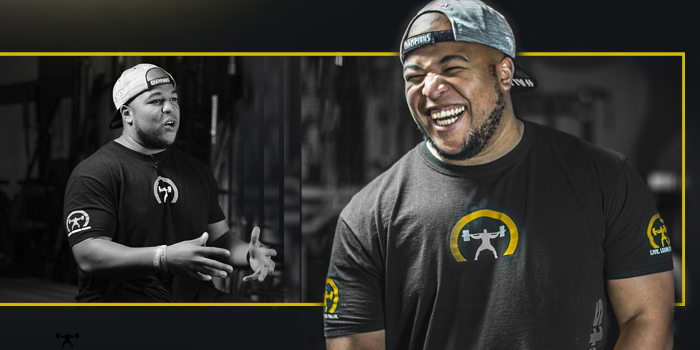
The holidays are a great time to sit back and reflect after as a very busy season comes to an end. I find myself usually lost in a book or reflecting on times past.
As of late, I’ve been lost in a lot of John Maxwell, so I decided to switch it up a tad and go back to dipping into Al Miller’s The System. I absolutely love this book and have found the simplicity and efficiency of the program, coupled with the logic behind the application, to be awe-inspiring. This made me think about the system I’ve been successful with in times past and what that looks like in its purest form.
RECENT: Top 5 Lessons I've Learned as a Coach
There have been a lot of modifications and a lot of malleability added to this system that depended on circumstances and situations. I’ve dubbed this hodgepodge of six years in strength and conditioning “Performance Drive Response,” a culmination of a bunch of different systems I’ve used, seen, and been in or part of.
I’d like to give credit to each man who has unknowingly put this system together. The periodization comes from Justin Lovett, Cal Dietz, and Dom Reno; certain exercise selections are from Ryan Cidzik and Todd Hammer; and the daily layout is from Matt Gildersleeve and Ryan Cidzik. And obviously, the great title is from Jeff Ward and Joe Kenn.
What is Performance Drive Response? There are a few very basic principles that make this system pretty simple yet comprehensive:
1. If we say that the exercises we test at the end of the year (for example, bench, squat, and clean) are our markers for performance, then we should be doing some form of that exercise every time we train.
2. In order to do these exercises every day, we tier the exercises in one of three categories: max effort, dynamic effort, and rep effort.
Max effort just means the pure form of the lift, regardless of intensity. Dynamic effort, of course, is the speed or velocity of the movement that actually moves fast (chains don’t mean speed; speed is speed). And last but not least, rep effort is our accessories (usually posterior that complements the lift). With rep effort, that’s not failure; that’s just whatever the periodized reps are. From an exercise selection standpoint, rep effort usually looks like Romanian deadlifts or a horizontal row.
I don’t rotate the tiers; instead, I rotate exercises, so for each day (three days a week of lifting), you are either doing a max effort, dynamic effort, or rep effort bench, squat, or clean, depending on the day.
For example:

3. Micro-dosing is a huge part in this program in terms of not only exercise selection but also in terms of conditioning and fieldwork, too. In order to lift maximally three days a week and also go out and produce high-intensity bouts of speed/change of direction work, rest needs to be at an absolute high.
What does that mean in a practical sense? Short lifts (45 to 50 minutes) with five to seven big exercises, tops. One prehabilitative FMS movement paired in with max effort and dynamic effort lifts and conditioning found through tempo in the weight room and tempo runs. In-between lift days in the past have been true Charlie Francis tempo runs. Those have been modified to striders by position grouping.
What does that look like? Day 1 and Day 2 are the same, but the overall volume rises until it eventually plateaus and stays the same, so as to not pull so much from the central nervous system that it becomes counterproductive in efforts to become stronger. For example, Day 1 and Day 2 may equal 1,800 to 2,000 yards of volume combined, then eventually taper off at something like 2,200 to 2,400. That would be a lot in a day.
Over the course of two days, though, that’s only 1,100 to 1,200 yards all done at a lower intensity that’s not so hard on the central nervous system that the body gets trashed. Anaerobic endurance comes from the dynamic effort work. Dynamic effort work can sometimes look like, sets x reps-wise, 14x2, or depending on the phase, 8-6x2.
4. Max effort, dynamic effort, rep effort, and fieldwork all can’t be maxed out the same. They cannot be all brought to a peak at the same time, and it’s important to know what exactly is the importance depending on what phase you’re at in your periodization. In my mind, absolute strength and work capacity are the pillars of athletic performance. They aren’t the end-all and be-all, but they’re pretty darn important.
My main priority is to increase absolute strength while peaking work capacity after I’m comfortable I’ve built it up efficiently enough for the sport. It’s not all about just being strong; it’s about learning to apply force fast, which is tough in sports where that force needs to be applied in something like a tenth of a second. That’s where dynamic effort and rate of force development play a major key *DJ Khaled. But I can’t do it all at once, and I can’t peak it all without one suffering, so I have to be smart.
RELATED: The Simplicity Project: Expanding to Two-A-Days for Size and Strength
As far as conditioning goes, we are conditioning to be able to handle practice; practice gets you ready for a game. At a certain point in time, practice gets the athletes ready for practice because they adapt to the demands placed on them.
Once I think I’ve gotten the athletes’ bodies able to handle practice from an aerobic standpoint, I don’t need to keep cooking them until the chicken burns. I can turn the heat down and just keep it cooking sufficiently without fear of overdoing it. Now let’s look at max effort, dynamic effort, and rep effort.
My max effort and rep effort will progress together. My dynamic effort will peak at the beginning of each max effort phase and maintain through that phase until the next peak.
For example, the hypertrophy phase for max effort may be Week 1, 3x10; Week 2, 3x10; Week 3, 3x8 (very basic linear; it’s not how I program. It’s just an easy example to follow).
Therefore, dynamic effort would look something like 12-14x2 for all three weeks (sets depend on where I think athletes are and what they need). Let’s say I’m entering a strength block in my max effort Week 4, 3x7; Week 5, 3x6; Week 6, 3x5 (again, it’s a very basic linear example).
The dynamic effort would now go to something more like 10x2 for these three weeks, and so on and so forth for the power peak. That way, by the time I go to peak, my dynamic effort has been the same for three or four weeks, so it’s not a new stressor the central nervous system has to adapt to on top of the constant change of intensity with the max effort.
READ MORE: Explosive Strength and Plyometric Options for Upper Body: How and When to Implement Them
Rep effort follows a similar flow where it peaks and maintains but still follows max effort. Again, not trying to full-on blow out the central nervous system in a two-week span (the week before training and the week of).
5. Now that I’ve explained the nuts and bolts of PDR, there’s one last principle I can cover to wrap things all up: periodization. I’ve explained the flow and how things fit together, but the concrete periodization is multifaceted.
I lay out the days in a Cal Dietz model (M intensity, heavy intensity, light intensity), but I do this by the tonnage of the lift performed based on population. This isn’t always a perfect guess, but it’s usually pretty spot on.
What does this mean? Based off my chart, clean is my moderate day, the squat is my Day 2 high-intensity day, and the bench is my Day 3 light intensity day. Most guys can clean more than they bench but squat much more than they bench or clean. Is that every athlete? Maybe not, but in my experience, it’s most.
The second facet of the periodization is the most important part: the wave periodization. The way I think about the waves is that it’s like watching a storm from a helicopter. There are multiple waves, but they are all heading in one general direction.
Here’s an example of an in-season periodization I’ve used before:

This is a very basic example, and it doesn’t go through the phases of hypertrophy and barely touches strength, but I will describe that here in depth. I believe that there is never a time where you don’t want work capacity, strength, or power from your athletes.
Based off of residual training effect, by the time I finally hit power/peak in some periodization models, I am no longer feeling the benefits from my hypertrophy block I did over a month ago in some periodization models. That is why I personally like the wave periodization model. The example above does not show this, but in an off-season model, you would see that we are constantly going through waves of hypertrophy, strength, and maximal strength.
As I get closer to the peak, the hypertrophy tailors off a little but can still be found in the dynamic effort training. Strength is not too far away from maximal strength in the wave model of periodization. Therefore, when we go to peak, we have the full benefits of hypertrophy, strength, and maximal strength.
I hope that everyone has enjoyed reading this in-depth view into the program that has garnered much success in the past. I cannot take sole credit for the creation or success of this program. When you work somewhere, you take what you like and don’t like, and add a mix of your own pizazz, then make it your own. I’ve been blessed to have been under 10 different head strength coaches and have run and designed my own programs under some of those head strength coaches. The success is a byproduct of their experiences and mentorship.











1 Comment